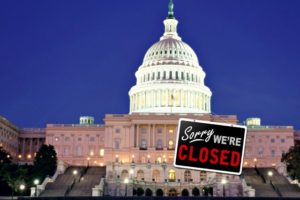For full 16 days in October 2013, the United States federal government shut down several of its operations. From October 1 to 16, the operations of a number of government departments were affected by the shutdown.
The US federal government was forced to shut down its non-essential services. With the US fiscal year ending on September 30, the US Congress has failed to enact legislation appropriating funds for the next financial year. Politicians basically have failed to come into terms with a new budget covering the period October 1, 2013 to September 30, 2014, creating a virtual “funding gap.” Without a budget agreement on hand, the US federal government simply cannot pay for its non-essential employees — leading to a furlough of hundreds of thousands of government jobs.
During a period leading to federal government shutdown, Republicans — who controls the House of Representatives — had been introducing cuts and delays to President Barack Obama’s Patient Protection and Affordable Care Act, which is more known as Obamacare. They tried to use the federal budget as a leverage to implement changes to Obamacare. However, the Senate – which is control by the Democrats, Obama’s party — has refused to budge, leading to an impasse and eventually the shutdown.
The shutdown, however, did not entail the entire US government. It only affected non-essential services. Essential services like social security and Medicare payments remained in operations. Likewise, the US military kept on its usual functions, save for thousands of hundreds of thousands civilian staff. A number of US federal departments have furloughed thousands of employees, those who are not performing essential services. The US Postal Service, a self-funded agency, remained open and was able to perform its functions. The US federal government shutdown also affected national parks like the Statue of Liberty, and the Smithsonian Institution, including the National Zoo. The shutdown likewise resulted to delays in veterans’ benefit cheques.
While the shutdown directly affected a number of federal government agencies and departments as well as operations, it also adversely affected the business sector. Particularly affected are those employed by private companies but who are working at government facilities or require government inspectors to complete their jobs. The shutdown also adversely affected small business in the US. They faced delays in their loans from the Small Business Administration. To shore up their finances, several of these small businesses had to turn to other sources of funding despite having to face higher interest rates.
Importers and exporters were also affected by the US government shutdown. With several regulators furloughed during the shutdown period, importers and exporters experienced considerable delays since there are products that require approval from authorities before they can be imported or exported. Among those products affected by the US government shutdown are lumber, pesticides and steel.
The US federal shutdown only lasted 16 days, shorter than the previous shutdown in 1995-1996, when President Bill Clinton and the House of Representatives failed to reach a deal on a budget to finance federal services. It lasted 28 days over two stages. The latest shutdown ended on October 16, 2013, when that evening the House of Representatives passed the Continuing Appropriations Act, 2014, with President Obama signing it on October 17, suspending the debt limit until February 7, 2014.



